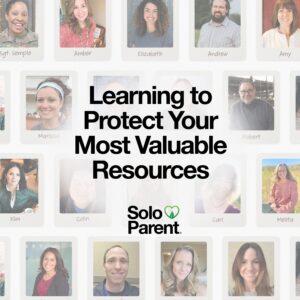Well we all know what instability feels like as single parents and many of us don’t want to rock the boat even more if we don’t have to. But sometimes we get stuck in what feels comfortable and we recognize things aren’t as they should be. They’re not healthy and not moving us forward. So how do we lean into rocking the boat in a sustainable, positive and purposeful way?
I think it’s funny to think about rocking the boat in a sustainable way. You keep rocking and rocking and rocking. All this month we’re talking about stability, and today we’re going to talk about what if I need to rock the boat. And in this conversation you’re going to learn how to normalize and demystify instability. Number two, how instability can actually lead to stability. And finally, how to purposefully disrupt your life. But if you take nothing else away from this podcast, I want you to remember these two things. Number one, you’re not alone. And second, there is hope that you can actually come out of this difficult season even better than before.
When you think about instability, a lot of us run from it. Some of us run towards it, but a lot of us run from it. So let’s unpack this and normalize what instability is and demystify it to a certain extent.
So as a widow, when people are giving advice, they say, “Don’t move out of your house for the first year.” They say to try to keep things as much the same as you can for your kids. So then I internalize that as a parent and say, “Oh, I have to keep stability. I have to keep everything the same because I’m trying to do what’s best for my kids.” And my kids have already lost a parent. There’s things that inherently are changing in dynamics, so they’ve been through so much instability. Don’t change things that you don’t have to, but sometimes I don’t think that that’s the best advice. Sometimes I think waiting and giving it pause and thinking through it: Great idea. But there’s a lot of benefit that can come from choosing sometimes: No, I need to rock the boat. A year and a half after Bill died, the boys and I moved up to Richmond, Virginia. I thought it was going to be awesome and solve all my problems. Exactly one year later we moved back to Nashville and that’s where we needed to be. Did I rock the boat too much? Did I break my children? No. I’ll tell you that we did change. My oldest went to four middle schools and for those of you who are counting, it’s only three grades. So he averaged more than one a year. That’s a lot. But I’ll also tell you, we have this game we play. It’s called Disrupt Us, and you take cards and it’s kind of a “what if” scenario game. You take a card, it gives you an item (like a suitcase) and you have to figure out how to improve it, how to make it better, how to use it for something different depending on what you’re playing with. My kids love this game because they’re taking something ordinary and figuring out how to disrupt it for a different purpose. Now, the funny part is last time we played it, we realized that the last probably 10 times, we recycled the same card. So we were disrupting the same exact thing. So there was some stability in it and we were like, “Why are we yet again merging a suitcase with a washing machine?” and trying to figure out how to do this predictably. But to think this is the game my kids gravitate towards because they like to disrupt things. They like to see some things changing around them.
The point of this demystifying and normalizing is that we can’t put instability in this box and think we need to be afraid of it, or that we need to avoid it at all costs. A lot of us have gone through so much change and instability, and we kind of put instability as a negative thing. The point in demystifying is there is always going to be a certain level of instability in our lives, and that’s okay. And that’s totally okay because instability can bring a lot of good things and we’re going to talk about that next. A lot of times too, growth can only happen in that pain of change and instability. You know what I mean? You can only create a new normal if something is disrupted or rebuild after something shattered. And I try to look at it like that.
Businesses often evolve the most during periods of instability. I was reading about this situation with Netflix. They used to be a DVD rental company. When that started declining, instead of trying to cling to their own model, they pivoted to streaming. Now this was risky because streaming technology at the time was still developing and not everyone was more comfortable and [they were] familiar with DVDs. So then they started shifting again into creating their own content. And we know the story, we know who Netflix is now, but they embraced the idea of disruption or instability. Elizabeth, you and I talk about this often as Solo Parent, we were starting support groups. We’d grown to 18 different states and into the military, and then the pandemic hit us and it was like, “Well, what in the world do we do now we can’t meet?” And Elizabeth, you said, “Well, let’s go online.” And that forever changed the trajectory of Solo Parent because we went online and we realized there’s a lot of single parents that are living on their phone that may not be able to go to a central location, but they need support every day. And so disruption became one of the biggest growing tools of our organization.
And I always think of the contrast. So you brought up Netflix, but on the other hand there’s Sears, which I think of as the original catalog company. They would send these catalogs out and people would wait for weeks for their Sears order. Well, Sears then went into stores and then who did Sears get beat out by? Amazon? They got beat by the next generation of their own selves. They knew how to do it and they forgot. So sometimes the alternative is not necessarily better
And this applies not only to business and big things, but also just in relationships. And as we’re looking at, “Are we in a toxic situation?” It may not be completely blatantly toxic, but it’s just not getting you where you need to go. I think it’s important to be willing to not be afraid of disruption, not be afraid of instability, and instead kind of embrace the idea of asking the question, what if this didn’t happen? Or what if we went online? Let’s not be scared of the “what if.” I’ll even say going with the relationship piece of it, you can look at it two ways. One, you could ask, “Is a disruption needed inside the relationship to help it grow?” Or do you need to disrupt your life and leave the relationship so that you can create growth and move forward? So that’s just a reset in that sense. And I think for our kids, as we’re parenting, as our kids get older, it’s not bad to ask ourselves, “Should I be doing this a different way?”
Let’s go into how instability can lead us to stability.
Stability doesn’t always mean calm or good. In the first point we talked about how stability provides the security that we need in order to remain calm and make great decisions and be able to move forward in a wise way, and that’s great. We need some of that security piece so that we can move forward in the right way in a wise way when it comes to creating change, I guess. But instability can drive change too. The rug gets ripped out from under you, what do you do? Sure, you can curl up in a ball in the corner, but what’s that going to serve? And so driving the change and harnessing it in a way that creates growth and creates opportunity versus chaos is really what we’re talking about. I think that’s really well said. So what you’re saying is in the simplest form, stability provides security, which is good. Instability drives change.
So I would say there is a difference between change and stability because I can change the color of my sheets on my bed every day and I’m creating change, but there’s also stability there. I always have that bed to go back to and sleep in. So there’s things that I can do if I want to go back to school—I may be keeping my job, I’m keeping my household finances stable, but I’m also still introducing change. I think sometimes the comfort of stability or the pursuit of safety—which is not bad—can keep people stuck in bad jobs or bad relationships, systems, routines that no longer serve them. I think it’s especially true in parenting, the comfort of stability: This is what our house is, this is the way we’re going to discipline, and we just keep it one size fits all for our kids. That’s not effective parenting because you’re not growing and you’re not changing. But that comfort [of predictability] can keep us in a place we can get stuck or in a dating relationship because you have someone to go on dates with or you don’t feel as lonely.
I would say in my first marriage, I stayed in a lot longer than I wanted to because I was afraid of what would happen if I wasn’t there to run interference with my kids and I wanted to be in that room when crazy happened so that I could lessen it. But then it did get to a point where at some point I was being more hurt, the kids were being more hurt in that situation and I was like, “I’m going to have to figure out how to let the rest play out. I don’t know all the answers on the other side, but I know where I am is not sustainable. I have to rock the boat.”
I think that’s why these two points initially are important as we get into actually purposefully disrupting our lives. It’s understanding first of all, instability is not negative. It’s not something to fear. And the second point is instability can actually lead to stability. I think a good example of this is when you’re lifting weights or working out, we actually create instability in our muscles by causing tiny tears in the muscle fibers, but our body responds by repairing and strengthening those fibers. It’s not comfortable to start this process, whether it be a toxic relationship we’re working out or any of these things, but we’ve got to believe that there is benefit in creating some instability. Not only is this something we don’t need to fear, but we need to start framing it as something to move towards.
I think that each one of us here could say that because of the instability that was created in our situations becoming single parents, we’ve actually created an even more stable environment on the other side of it because of our healing and our growth and the things that have happened. I know I’ve said it over and over, I’m a better mom, I’m a better coworker, I’m a better friend, better co-parent, all of the things. And because I’m a better person, I’m able to create a more stable and loving environment for my child. Sometimes we just have to have it in order and know that this short-term instability is actually going to provide something on the other end that’s beneficial for everyone.
If we know that we shouldn’t fear instability and we know that instability can actually lead us to stability, how do we rock the boat? How do we purposefully disrupt our lives?
So you’re sitting in a dark room thinking to yourself, “This just doesn’t work for me anymore.” And sometimes you don’t know what this is. So I think the first thing is to figure out, “What is this? Is it the relationships I’m in? Is it the way that I’m parenting? Is it the way I’m taking care of myself? Is it my job? Is it the things I choose to do in my free time?” Because there’s a whole lot of things that you change a little bit and actually change a lot about your life. If you change the three people you hang out with the most. For example, you can completely rewrite your life and where you’re going and how you think about things. What’s being fed into your mind? So I would say the first thing is to try to figure out what is it that you need? What boat do you need to rock in order to get to the change that you need? What really isn’t working?
I know that a change is needed or something’s there. How do you identify that? How do you identify when you’re in that dark room and you’re like, “Something’s not right, but I don’t know what it is.” How do you know what it is?
I think of sitting there and not knowing what is not quite right. I have to think about, “Where’s the pebble in my shoe?” It may be small, but do I have this feeling after every time I say goodbye to the person I’m dating? Well there might be something in that relationship. Do I have this feeling every time I go to work and yet on Saturdays and Sundays I feel amazing and I don’t have this problem? Maybe there’s something wrong with my job. Do I have this guilt every single time I eat a gobstopper? Maybe there’s something wrong with my diet. No matter how small it is, I know it’s on my left big toe, and every time I take the step, I just get grated by it. That’s where I need to go and start looking to try to figure it out.
Bringing the right people around you to help you figure that out is sometimes really necessary because I could very easily catastrophize the whole thing, the whole relationship, because of old wounds. I could just toss the baby out with the bathwater. I’ve been known to do that. I’m not talking about this past relationship, but what I’m about to say is sometimes inside this relationship, there are some small tweaks that need to be made that need to be disrupted inside the relationship. And those things work, those things don’t, and then it builds and then maybe you find some stability there. And then [there’s also times] when it’s time to make the big change. And so it doesn’t mean that you just go all out and say, “I’ve got to get rid of everything in my life and completely uproot.” No, it doesn’t. But looking at even just the small changes that might need to be made that could create stability. And so even with a morning routine, for instance, not picking up your phone as soon as you wake up. Maybe if you notice that you have anxiety as soon as you wake up, change what you’re doing with your phone first thing in the morning. Or maybe spend 10 minutes journaling in the morning. Or take a quick walk after dropping the kids off at school. There are small changes that you can make that can lead to a greater outcome versus you just disrupting a huge thing.
I don’t want to gloss over the people thing. Because I was thinking too, as much as the people can be helpful in helping you figure out what is it that needs to change, having those people there, they can actually create some of the stability for you while you’re changing things or some of the stability for your kids. So let’s say it’s my job. That’s the pebble in my shoe. I need to go back to school to get that. If one of those peoplecan help grab my child from off the school bus and keep him entertained for two hours while I’m studying for classes, that puts in a whole bunch less instability for my child. Well, maybe I’m rocking the boat, but he doesn’t feel those changes as much. He thinks he’s having regular play dates that he loves. So if there’s places we can put people in as even temporary backstops to try to help, it may not be today, may not be the time to make that change. On May 1st I have to focus on making sure I have the people around me to help me make the change as step one. And then I focus on the change. And that could take a matter of weeks. It could take a year or more. And I’m going to have to be patient and say, “No, this is part of working towards my ultimate goal.”
I love that you pointed out the time element because it isn’t “I need to change. Let’s just blow it all up.” It really does take a process. And I think that’s why this point of bringing people with you into the boat that you’re going to rock is so important. And that does not mean every time you talk to someone on social media or in person, you spill your guts to everybody. It’s really about being deliberate. Who are those anchor people? I have someone from a spiritual perspective who I go to talk about that. If it’s something business wise, I know who I go to talk about that. If it’s relationships, it’s the counselor. Getting the right people on the boat with you is a key to moving into being disruptive or rocking the boat.
I would just say the trick is to figure out how to rock the boat, not capsize it or sink it. As we’re looking at whether we should rock the boat or not, and then walking into actually doing that, I think it’s really important to assess the risks and the rewards we need to evaluate. Will shaking things up lead to positive change or is it just for the sake of disruption? So looking at it from a cost analysis standpoint, there is a cost to rocking the boat. It’s uncomfortable. We may lose people, we may be lonely again, we may not have the security of a job. Whatever it is, there’s a cost associated with it. There’s also a cost associated with staying in the same boat and not rocking it. So I think it’s really important to be honest with ourselves and with other people about, “Okay, am I weighing this out appropriately?” We all have blind sides and we all get emotional. Usually when you’re walking towards disrupting something or rocking the boat, it is because you have some big feelings about it. And so whenever you have big feelings, it’s great to have sounding boards for that.
You really need to know who you are as a person and whether you are likely somebody who’s like, “I don’t care. I’m going to do it anyway.” And you like to jump off cliffs, you are likely to[look at] the cost analysis and do it anyway. And maybe you need to listen to that voice in your head that says no. Or maybe you don’t have that voice and you need to listen to your friend’s voice that tells you not to [do it]. But on the other side, you can also be somebody who can find the problem with everything and the reason not to do anything, and you can become paralyzed by it. So no, I’m not going to do this. It can be easier to see the problems that we face on the other side, thinking, “Well, if I do this, all of this bad stuff is going to happen” but not understand and not give any weight or cost or allowance for all of the good things that will happen.
A study asked people how happy they thought they would be if they lost the use of their body and became quadriplegic. Everybody was like, “Oh, my life would be over, I would hate it. It would be awful.” And then they went and they asked people who actually were quadriplegics and the quadriplegics were way happier than people thought they would be if they had been made quadriplegic. The point being, if you’ve got the personality, and I do, so I’m putting myself right there, you can see all the problems with taking that next step, but you may not be able to see any of the benefits that are on the other side. And when you’re doing a real cost analysis, (this is coming from an accountant), you need the revenue and the cost. You can’t just take the cost into it. So where’s the value that’s also coming in that equation
We talked that uncertainty piece and how much fear that can create too, and how it can keep us stuck. And so I think you have to be not as risk averse because of the uncertainty and the fear because that can drive you crazy for sure. And the overthinking. So it’s just this balance of letting the fear take over and overthinking, and then there’s jumping off a roof with no parachute and not thinking about it.
And I think it’s impossible to do that by yourself, which is why we talked about bringing someone into the conversation. For me, I think the most disruptive thing that I’ve done when I was first a single parent is deciding to get married again, deciding to date not as much of a disruption, but we had created a new normal in our house. It had been eight years that I was raising my girls on my own. I started dating Barb. We dated for three and a half years, which is a pretty long time. But it was going to go one of two ways: just kill it or move into the next step. And I remember being so locked in with fear that I didn’t want to disrupt the girl’s life again. It kept me from saying something to them. And I did bring people into this conversation and talked about it a lot. And I remember stepping into the uncomfortable situation of telling the girls, I didn’t ask them. I told them, “I’ve made a decision to get married again. I’m going to marry Barb.” And it was not met with happiness. It was the opposite of that. It was like, “Dad, please don’t do this to us. Please don’t do this.” But I was so confident that I needed to move in a direction that it was kind of, I almost detached from that and let them have their feelings about it because I was so convinced that it needed to be a step. I needed a step into discomfort. I needed to rock the boat. But it doesn’t mean that everyone’s going to agree, especially when you’re rocking their boat too. I mean, the girls all now love Barb, and it’s all great, but it required rocking the boat and introducing disruption, and that’s really hard. So I think the point I’m trying to make is you’ve got to be ready for resistance. Change often meets pushback, so we need to communicate as clearly as we can, but we also need to stand firm if we’ve had the accountability of other people speaking into this because it is really hard to do and not everyone is going to understand.
I would even say months down the road, years down the road, you can have moments, and I do this where it’s like, “Well, I miss this.” I’m remarried and there’s times when I’m like, “I miss being single and I love Matt, but there’s this freedom that I did not embrace when I was there,” and once in a while, I’m like, “Oh, I miss that.” That does not mean it was wrong for you to disrupt. It does not mean that you need to now disrupt everything and become single again. It just means there’s pros and cons of everything,
Takeaways
- It’s normal to want to avoid instability, but there are a number of pros to instability. It reveals what’s not working and brings underlying problems to the surface. It’s nothing to be completely afraid of.
- Number two, instability is the force that leads to long-term stability. In the short term, stability provides security, but instability drives change.
- And third, purposeful disruption is key. It doesn’t mean chaos. It means being bold and making intentional changes, and there are ways to do that. I think number one within that is bring people into it with you.
Listener Question
If you had a free hour every day, what would you do?
Go into a dark room and close the door. I’m not kidding. That’s my jam. Actually, the last trip we took, I think I said, “Do you need your dark room now?” Well, after going and doing the capitol and dealing with senators and talking it’s like, “Please just give me a dark room.” But to me, that’s true. I’ve learned a lot about myself and there’s this thing called highly sensitive person (HSP)–and I’m definitely that—where I recharge.
If I say I would join a Solo Parent group every single day of the week, is that kind of like giving the “Jesus” answer in church? I am an HSP too, a highly sensitive person, so I totally get what you’re saying. And so I don’t know if I could do it seven days a week. It’d be some people sprinkled in with some other non people. But the older my kids get, the more time I am finding, and I need to figure out how I’m going to fill this time. I’m in that transition phase where my kids are both driving now. One’s out of the house and I’m on a new adventure. So I haven’t fully answered this question for myself yet..
I think it would look different every day. That instability would be a stable routine.Routine is not, monotony is not my thing. I can’t do that. And I say that it looks different every day because I create space for myself, whether it’s at night or in the morning before Jax wakes up, whatever it is. I do have the luxury of 50\50, so on the weeks that I don’t have him, I’m able to have some time for myself. Every day it looks different. Might be going for a run, might be journaling, it might be praying, it might be scrolling, it might be reading a book. It just, sometimes it’s healthy, sometimes it’s not.
We love hearing from you. If you want to send in a question, go to our website and you will find instructions on how to email, call, or leave a voice message. You can also head over to Instagram or Facebook and send us a question there as well.




